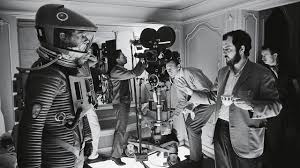Stanley Kubrick (1971-1987)

Known for his intense formality, intellectual rigor, and exacting approach to filmmaking, Stanley Kubrick consistently sought to challenge both his audience and the conventions of cinema. In his later years, he cemented his status as a filmmaker whose work was as much about technique and craft as it was about exploring profound existential and philosophical themes. Kubrick’s reputation as a meticulous perfectionist is well-earned, with each of his films from this period showcasing a rigorous control over every element, from visual composition to sound design. His works are intellectually demanding, often requiring repeated viewings to fully unpack their complexities, ultimately proving to be some of the most enduring and influential works in cinema history.
A Clockwork Orange (1971) Based on Anthony Burgess’s novel, A Clockwork Orange follows Alex DeLarge (Malcolm McDowell), a teenage delinquent who indulges in “ultraviolence,” until he is subjected to a government-sponsored behavioral treatment meant to “cure” him. The film is a dark meditation on free will, societal control, and the morality of psychological manipulation. It’s style, from the futuristic set designs to the iconic costumes (including Alex’s bowler hat and white jumpsuit), became deeply influential, and was largely responsible for shaping the look of cinema in the 1970s. McDowell’s performance as Alex is chillingly magnetic, effortlessly blending the character’s sadistic tendencies with moments of vulnerability. Kubrick’s use of close-ups and camera movements creates a psychological intensity that draws the viewer into Alex’s deranged world. His use of classical music, particularly Beethoven’s 9th Symphony, in conjunction with scenes of brutal violence, creates an eerie juxtaposition that reinforces the film’s unsettling tone. Often accused of glorifying this violence, it remains a dark, fascinating exploration of human nature, as provocative and pertinent today as it was upon its release.
Barry Lyndon (1975) After the provocative success of A Clockwork Orange, Kubrick switched gears with Barry Lyndon, a slow-burn period drama that showcased his mastery of visual storytelling. Based on William Thackeray’s novel, the film follows the rise and fall of an Irish adventurer in the 18th century. Unlike most historical epics, Kubrick’s approach to Barry Lyndon is deliberately cold and detached, creating a story that feels as if it were observed through the lens of an impartial historian. His use of natural lighting, using custom-built lenses to capture the soft glow of candlelit, is a groundbreaking achievement in cinematic grandeur, giving the film a rich, artistic quality that mirrors the works of 18th-century painters. The beautifully composed shots and rich visual textures underscore the film’s layered exploration of class, ambition, and human folly. The film’s pacing is deliberate, as the emotional distance created by Kubrick’s slow, methodical storytelling allows for a more profound exploration of the emptiness that accompanies social ambition and the inevitability of fate. Initially met with mixed reviews, it is regarded as one of Kubrick’s finest achievements, praised for its visual beauty, narrative complexity, and thematic depth.
The Shining (1980) With The Shining, Kubrick turned his attention to the horror genre, loosely adapting Stephen King’s novel about a family’s terrifying experience at an isolated hotel. On the surface, The Shining might appear as a conventional ghost story, but Kubrick’s interpretation takes the narrative to disturbing, cerebral heights. The Shining is a study of isolation, mental disintegration, and the terrifying consequences of familial dysfunction. Jack Nicholson’s iconic portrayal of Jack Torrance as a man descending into madness, combined with Kubrick’s precise framing and eerie sound design, creates an atmosphere of unrelenting tension. Kubrick’s ability to manipulate space is masterful, with the vast, empty corridors and maze-like layout of the Overlook Hotel mirroring Jack’s fractured mind and psychological unraveling, his haunting, disorienting camera work intensifying the viewer’s unease. The Shining is not a typical horror movie but rather a psychological exploration of madness, making it a landmark in the genre. It is a film that remains as unsettling and enigmatic as ever, cementing Kubrick’s legacy as a director who could redefine the boundaries of genre filmmaking.
Full Metal Jacket (1987) Kubrick’s final film of this period, Full Metal Jacket, provides a grim examination of the Vietnam War, with a unique structure that splits the film into two distinct halves. The first half focuses on the brutal training of Marine recruits at Parris Island, dominated by R. Lee Ermey’s unforgettable performance as the sadistic Gunnery Sergeant Hartman, whose drill instructor character pushes the recruits to the brink of madness. The second half, while less focused, follows one of the recruits, Joker (Matthew Modine), as he navigates the chaos and brutality of the war, and captures the disillusionment and nihilism that come with combat, particularly in the harrowing final sequence set in the streets of Hue City. The film’s stark, unsentimental view of combat is a trademark of Kubrick’s worldview, and his attention to detail is evident in every frame, from the striking use of color and light to the sharp, cold dialogue that underscores the moral ambiguity of war. While uneven, Full Metal Jacket remains a chilling portrait of the psychological toll of military life, as well as a brilliant exploration of the absurdity of war.
Overall Appraisal Stanley Kubrick’s work from 1971 to 1987 demonstrates his unparalleled ability to reinvent genres and engage with complex philosophical themes. From the brutal violence of A Clockwork Orange to the meditative melancholy of Barry Lyndon, Kubrick consistently challenged audiences and pushed the boundaries of cinematic form. His films are marked by their intellectual depth, technical precision, and unflinching exploration of the darker aspects of human existence. While some critics and audiences struggled with the emotional distance and intellectual rigor of his work, Kubrick’s films have only grown in stature over time. His meticulousness as a director, combined with his refusal to cater to conventional storytelling, ensures that his films remain not only highly influential but also deeply relevant to this day. Kubrick’s work from this era is a masterclass in filmmaking, and it cements his legacy as one of the greatest directors in the history of cinema.
